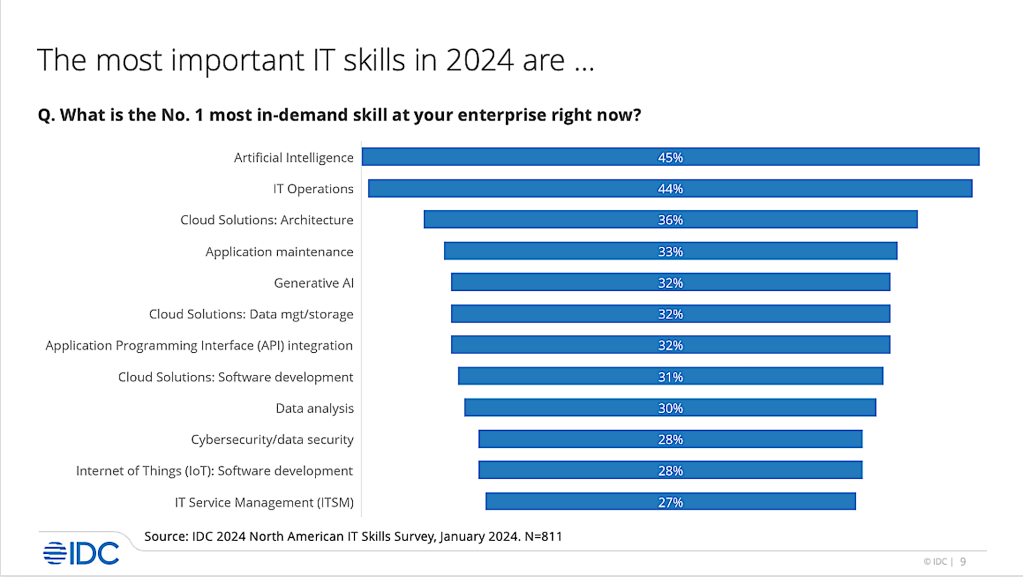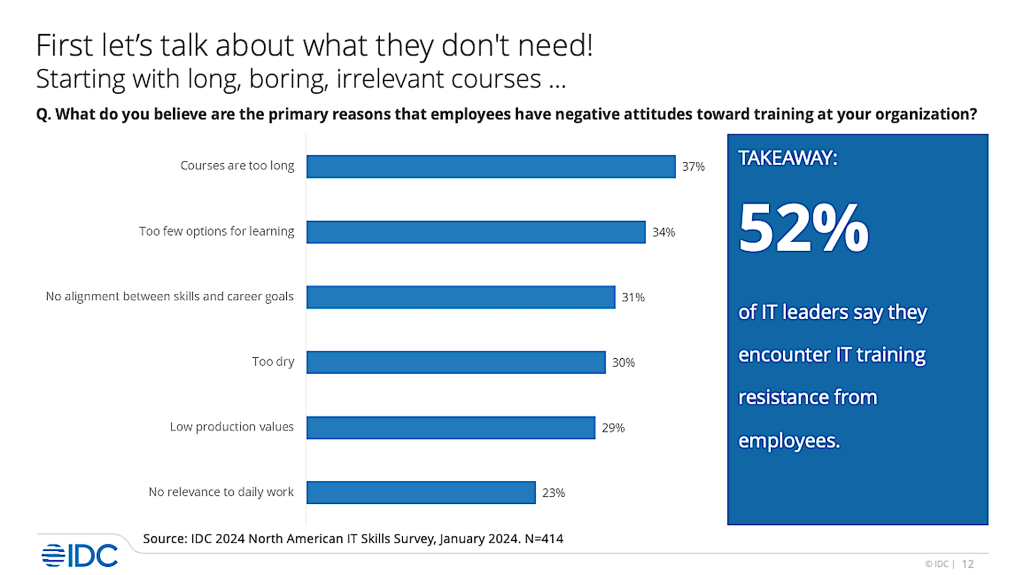Along with AI skills, skills in IT ops and cloud development are severely lacking, IDC reports.

A growing IT skills shortage is impeding organizations from completing digitization projects and adopting new technologies including generative artificial intelligence (genAI), and it's hitting the bottom line in several ways.
In a recent IDC Research survey of more than 800 North American IT leaders, nearly two thirds said that a lack of skills has resulted in missed revenue growth objectives, quality problems, and a decline in customer satisfaction.
And the situation is not expected to get any better. IDC predicts that by 2026, more than 90% of organizations worldwide will feel the pain of the IT skills crisis, amounting to some$5.5 trillion in losses caused by product delays, impaired competitiveness, and loss of business.
Sixty-three percent of more than 800 IT leaders surveyed said a lack of skills has delayed digital transformation initiatives, most by an average of three to 10 months.
While it's no surprise that artificial intelligence (AI) skills are currently the most in-demand skill for most enterprises, IT Operations are a close second. Additionally, a variety of cloud skills, including architecture, data management and storage, and software development, are among the ten most needed skills identified by survey respondents.

IDC
This situation is further compounded by the need for additional, non-technical skills, such as digital business skills, human skills, and leadership skills, according to Gina Smith, PhD, research director for IDC's IT Skills for Digital Business practice.
"Getting the right people with the right skills into the right roles has never been so difficult," Smith said in a statement. "As IT skills shortages widen and the arrival of new technology accelerates, enterprises must find creative ways to hire, train, upskill, and reskill their employees. A culture of learning is the single best way to get there."
The IDC report Enterprise Resilience: IT Skilling Strategies, 2024 presents a framework for how enterprises can address the IT skills shortage. It includes data from IDC's 2024 North American IT Skills Survey as well as best practices for cultivating a culture of learning in the enterprise.
With AI 'sucking the air out of almost all non-AI investments in the whole tech world,' companies are cutting what they believe are unnecessary jobs - and replacing them with AI-skilled workers. In the first quarter of 2024, US companies announced plans to cut 257,254 jobs, up 120% over the final quarter of 2023, according to a report by outplacement firm Challenger, Gray & Christmas. The surge in layoffs was led by the tech sector, followed by government positions.
Ironically, genAI - one of the most critical skills workers lack - is likely to play a critical role in addressing skills shortages in today's marketplace, according to a recent study by London-based Kaspersky Research. It showed that 40% of 2,000 C-level executives surveyed plan to use genAI tools such as ChatGPT to cover critical skills shortages through the automation of tasks.
"If there's a desire to delegate critical activities and functions to genAI, it is essential that senior management first develops a deeper understanding of the data management processes, including what data can and cannot be used to train these systems," said David Emm, Kaspersky's principal security researcher.

IDC
A common concern among employees is that genAI will replace job positions. However, both anecdotal evidence and research has shown that like other tech advances in the past, genAI is likely to create more jobs than it replaces. And employees who are replaced by genAI are more likely to be replaced by someone who knows how to use AI as part of their skill set.
According to Forrester Research's 2023 Generative AI Jobs Impact Forecast, the technology will influence 4.5 times more jobs than it replaces. The technology will also make up nearly 30% of the jobs that are lost to automation by 2030.
"We forecast that generative AI will replace 90,000 jobs in 2023, growing to 2.4 million by 2030," the study said. While 2.4 million jobs replaced by genAI sounds high, Forrester notes that automation and AI overall will replace just 4.9% of US jobs by 2030. And job losses over the next two years will remain modest until questions about intellectual property rights, copyright issues, plagiarism, model refresh rates, model bias, ethics, and model response reliability are resolved, the research firm said.
The latest report from the International Monetary Fund (IMF) on the impact of genAI reads like a "best of times, worst of times" tale. The study found as much as 60% of jobs will be exposed to the effects of AI. About half of the jobs affected by AI and genAI could benefit from enhanced productivity. For the other 50%, however, genAI tools could be used to execute tasks now done by humans, which could lower labor demand, lead to lower wages, and reduce hiring.
"Many studies have predicted the likelihood that jobs will be replaced by AI," the study said. "Yet we know that in many cases, AI is likely to complement human work."
But that requires employees who know how best to work with AI. Rick Villars, group vice president for research firm IDC, said his analysts have seen that enterprises are "again and again" increasing budgets for genAI and other forms of AI, including building out infrastructure, services, and software platforms.
"The one thing they're not increasing at the same level is the investment in training and upskilling their own teams," Villars said. "That's about the IT teams and the subject-matter experts. But it's also just training their employees on better AI behavior and practices so they can protect their information."
Training workers to utilize AI and big data (huge amounts of structure and unstructured information) ranks third among company skills-training priorities over the next five years, and it will be prioritized by 42% of companies, according to a survey by the World Economic Forum.
Among the challenges organizations face when trying to expand the skills of their employees is resistance to training. Employees complain that the courses are too long, the options for learning are too limited, and there isn't enough alignment between skills and career goals, according to IDC's survey.

IDC
To overcome these challenges, IT leaders need to employ a variety of strategies to encourage a more effective learning environment within their organization. That includes everything from classroom training to hackathons, hand-on labs, and games, quests, and mini-badges.
But fostering a positive learning environment in an organization requires more than just materials, courses, and challenges. Culture change begins at the top, and leaders need to demonstrate why learning matters to the organization.
"This can be done by aligning employee goals with business goals, promoting continuous learning throughout the employee's journey, and creating a rewards program that recognizes process as well as performance," IDC's report stated. "It also requires the allocation of adequate time, money, and people resources."
Training that engages employees also translates to "experiential learning" or hands-on training. More than eight in 10 IT executives surveyed by IDC indicated they're either already using experiential learning techniques or plan on implementing them this year.
Nearly three out of four (70%) IDC survey respondents said they are already utilizing experiential learning methods, which includes labs, games, and hackathons. And genAI has also found its way into the current training environment, with more than half the organizations surveyed using or piloting it for IT training.
Most, but not nearly all of those surveyed said they also reward employees with project or role-based mini-credentials to encourage continued skills development.

 English
English Pусский
Pусский Français
Français Español
Español Português
Português
































 Tags quentes :
Tags quentes :
